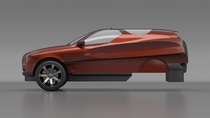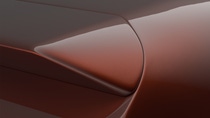Media
The endless variations of SUPERPOSITION – BASF 2021-2022 Automotive Color Trends collection

Each year, the designers at BASF’s Coatings division create a new color collection to inspire automotive designers. They draw their inspiration from industry, fashion, consumer products, nature, and more. They look to societal trends and cultural influences – as well as the growing demand for sustainability and functionality – to identify and craft new color spaces.
This year’s collection is called SUPERPOSITION. Borrowing from a phenomenon found in quantum mechanics, superposition defines a state where the limitation of binary systems is overcome. In other words, things aren’t just black or white, heads or tails, one or zero. The world has an uncountable number of variations in-between. This collection immerses itself in those variations.
The idea behind quantum computing and superposition is that it takes the possibilities from the world of the binary ones and zeros, which has been the foundation of our digital world, and allows computers to access everything that's in between the ones and the zeros.
“This fluidity unleashes a vast amount of potential for finding solutions, whether it's technology enabling autonomous driving, developing better predictions for weather patterns, or looking at extending battery lives”, explains Paul Czornij, head of design, BASF, Americas.
The key color created by Czornij’s team for North America is Lambent Earth. It represents the essence of the bountiful energy and fragility in the world, combining a fiery glow with a natural brown. The hue comprises flashy effects and deeply saturated colorants that extend beyond just being a pretty color; they’re a testament to the myriad of possibilities attainable from the physics of light dancing on a coated surface.

Lambent Earth combines a fiery glow with a natural brown. It captures the superposition of the natural with the technical in one vibrant color space.
Lambent Earth utilizes some of the most cutting-edge BASF technology, combining very deep, chromatic and transparent reddish colorants, reflective of the North American landscape, with beautiful pigment effects that make the color almost glow.
The result is a balance that strikes a chord with human steadfastness. This color anchors itself in optimism and resilience, showing the potential for humanity to move forward despite the challenges.
Czornij notes that the color trends were developed during the pandemic. “Even though we're projecting the colors out into the future, we're very [influenced by what is happening at the time]. I thought that eventually we were going to get through as individuals, that we were going to get through collectively. In designing these new color concepts, resilience was something that I wanted to make sure was built into the colors.”
Another priority for the Coatings Team is meeting the demand for increased functionality and sustainability.
The team is stretching color concepts beyond the realm of visual aesthetics into the realm of the next level functionality. When developing concepts, they work synergistically with the automotive designers who create the car bodies so that the various contour lines, the shoulders, and the overall form of the car are all elevated.
They also work with the different colorants in their toolbox to create a new dimension of perception, applying layer upon layer of paint to use the concept of superposition and coming up with something fresh and inventive.
What's really exciting for us in Coatings design is that we can use the concept of superposition and put multiple layers of paint on each other or see how pigments interact with each other in limitless compositional formulations and unleash a wide, diverse range of colors.
The Coatings team has even created a color to specifically address an engineering challenge with LiDAR (Light Detection and Ranging). LiDAR is a remote sensing method that uses light in the form of a pulsed laser to measure distances and is the technology used for autonomous vehicles. Metallic colors such as silver create a challenge for LiDAR because the color changes in different light and tends to be more complex in determining how reflective they will be on the road from different angles. The team developed an automotive silver with an additional superposition layer of functionality to help enable LiDAR detection.
Another area of focus has been on sustainable colors. This year the team developed a color combining a biorenewable pigment with traditional colorants, capturing the essence of superposition.
Sustainability is a driving factor at BASF. Our designers pinpoint trends and the forward-looking signals that influence those trends as they work to create innovative shades and formulations that reinforce BASF’s global leadership in color. The latest palette, or some version of it, could be on the road and in your driveway in the next three to five model years.
To learn more about the BASF Color Report 2021-22 for Automotive OEM Coatings, click here.
Published on April 28, 2021, by Laura Buoncuore.
For media inquiries or to repurpose this article, please contact Lisa Brown.
